Hyundai Santa Fe (TM): Blind-Spot Collision-Avoidance Assist (BCA) / System malfunction and limitations
System malfunction
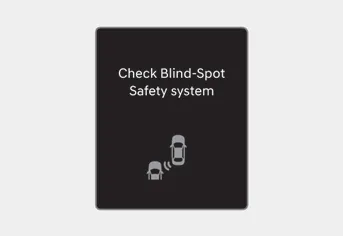
When Blind-Spot Safety system is not working properly, the ‘Check Blind-Spot Safety system(s)’ warning message will appear on the cluster, and the system will turn off automatically or the system will be limited. We recommend that the system be inspected by an authorized HYUNDAI dealer.
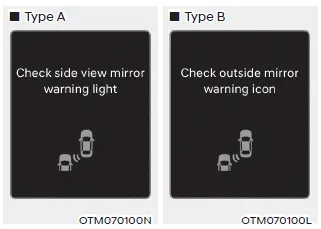
When the side view mirror warning light is not working properly, the ‘Check side view mirror warning light’ (or 'Check outside mirror warning icon') warning message will appear on the cluster. We recommend that the system be inspected by an authorized HYUNDAI dealer.
System disabled
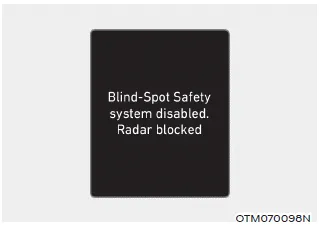
When the rear bumper around the rear corner radar or sensor is covered with foreign material, such as snow or rain, or installing a trailer or carrier, it can reduce the detecting performance and temporarily limit or disable Blind-Spot Safety system.
If this occurs, the ‘Blind-Spot Safety system(s) disabled. Radar blocked’ warning message will appear on the cluster.
The system will operate normally when such foreign material or trailer, etc. is removed, and then the engine is restarted.
If the system does not operate normally after it is removed, we recommend that the system be inspected by an authorized HYUNDAI dealer.
WARNING
- Even though the warning message does not appear on the cluster, Blind- Spot Safety system may not properly operate.
- Blind-Spot Safety system may not properly operate in an area (e.g. open terrain) where any objects are not detected right after the engine is turned on, or when the detecting sensor is blocked with foreign material right after the engine is turned on.
CAUTION
Turn off Blind-Spot Safety system to install a trailer, carrier, etc., or remove the trailer, carrier, etc. to use Blind-Spot Safety system.
Limitations of the system
Blind-Spot Safety system may not operate normally, or the system may operate unexpectedly under the following circumstances:
- There is inclement weather, such as heavy snow, heavy rain, etc.
- The rear corner radar is covered with snow, rain, dirt, etc.
- The temperature around the rear corner radar is high or low
- Driving on a highway (or motorway) ramp
- The road pavement (or the peripheral ground) abnormally contains metallic components (i.e. possibly due to subway construction)
- There is a fixed object near the vehicle, such as sound barriers, guardrails, central dividers, entry barriers, street lamps, signs, tunnels, walls, etc. (including double structures)
- Driving in large areas where there are few vehicles or structures (i.e. desert, meadow, suburb, etc.)
- Driving through a narrow road where trees or grass are overgrown
- Driving on a wet road surface, such as a puddle on the road
- The other vehicle drives very close behind your vehicle, or the other vehicle passes by your vehicle in close proximity
- The speed of the other vehicle is very fast that it passes by your vehicle in a short time
- Your vehicle passes by the other vehicle
- Your vehicle changes lane
- Your vehicle has started at the same time as the vehicle next to you and has accelerated
- The vehicle in the next lane moves two lanes away from you, or when the vehicle two lanes away moves to the next lane from you
- A trailer or carrier is installed around the rear corner radar
- The bumper around the rear corner radar is covered with objects, such as a bumper sticker, bumper guard, bike rack, etc.
- The bumper around the rear corner radar is impacted, damaged or the radar is out of position
- Your vehicle height is low or high due to heavy loads, abnormal tire pressure, etc.
Blind-Spot Safety system may not operate normally, or the system may operate unexpectedly when the following objects are detected:
- A motorcycle or bicycle is detected
- A vehicle such as a flat trailer is detected
- A big vehicle such as a bus or truck is detected
- A moving obstacle such as a pedestrian, animal, shopping cart or a baby stroller is detected
- A vehicle with low height such as a sports car is detected
Braking control may not work, driver’s attention is required in the following circumstances:
- The vehicle severely vibrates while driving over a bumpy road, uneven road or concrete patch
- Driving on a slippery surface due to snow, water puddle, ice, etc.
- The tire pressure is low or a tire is damaged
- The brake is reworked
- The vehicle makes abrupt lane changes
WARNING
• Driving on a curve
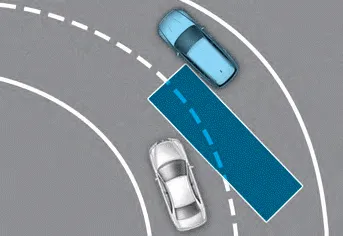
Blind-Spot Safety system may not operate properly when driving on a curved road. The system may not detect the vehicle in the next lane.
Always pay attention to road and driving conditions while driving.
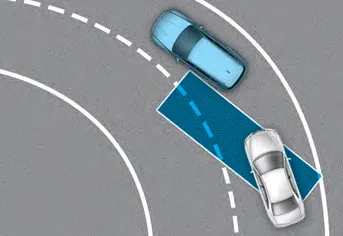
Blind-Spot Safety system may not operate properly when driving on a curved road. The system may recognize a vehicle in the same lane.
Always pay attention to road and driving conditions while driving.
• Driving where the road is merging/ dividing
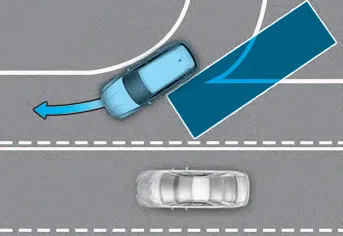
Blind-Spot Safety system may not operate properly when driving where the road merges or divides. The system may not detect the vehicle in the next lane.
Always pay attention to road and driving conditions while driving.
• Driving on a slope
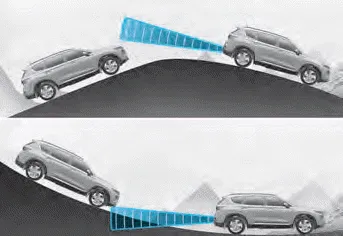
Blind-Spot Safety system may not operate properly when driving on a slope. The system may not detect the vehicle in the next lane or may incorrectly detect the ground or structure.
Always pay attention to road and driving conditions while driving.
Information
Radio frequency radiation exposure information:
This equipment complies with FCC radiation exposure limits set forth for an uncontrolled environment.
This equipment should be installed and operated with minimum distance of 8 in. (20 cm) between the radiator (antenna) and your body.
This transmitter must not be co-located or operating in conjunction with any other antenna or transmitter.
• Driving where the heights of the lanes are different
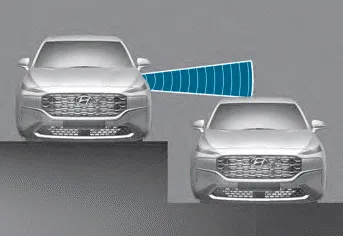
Blind-Spot Safety system may not operate properly when driving where the heights of the lanes are different. The system may not detect the vehicle on a road with different lane heights (underpass joining section, grade separated intersections, etc.).
Always pay attention to road and driving conditions while driving.
WARNING
- When you are towing a trailer or another vehicle, make sure that you turn off Blind-Spot Safety system.
- Blind-Spot Safety system may not operate normally if interfered by strong electromagnetic waves.
- Blind-Spot Safety system may not operate for 3 seconds after the vehicle is started, or the front view camera or rear corner radars are initialized.
Information
This device complies with Part 15 of the FCC rules.
Operation is subject to the following three conditions:
1. This device may not cause harmful interference, and
2. This device must accept any interference received, including interference that may cause undesired operation.
3. Changes or modifications not expressly approved by the party responsible for compliance could void the user's authority to operate the device.
Information
Radio frequency radiation exposure information:
This equipment complies with FCC radiation exposure limits set forth for an uncontrolled environment.
This equipment should be installed and operated with minimum distance of 8 in. (20 cm) between the radiator (antenna) and your body.
This transmitter must not be co-located or operating in conjunction with any other antenna or transmitter.
System warning and control Vehicle detection To warn the driver a vehicle is detected, the warning light on the side view mirror and head-up display (if equipped) will illuminate.
After the vehicle stops, when an approaching vehicle from the rear area is detected as soon as a passenger opens a door, Safe Exit Assist will warn the driver with a warning message and an audible warning to help prevent a collision.
Other information:
Hyundai Santa Fe (TM) 2019-2023 Service and Repair Manual: Specifications
Specifications [ADAS_PRK Application Specification (MOBIS)] Item Specification Ultrasonic sensor Voltage rating DC 12V Detecting range 40cm ~ 120cm Operating voltage DC 9V ~ 16V Operation curr
Hyundai Santa Fe (TM) 2019-2023 Service and Repair Manual: Schematic diagrams
System Block Diagram Component Parts And Function Outline Component part Function Vehicle-speed sensor, ESP/ABS Control Module Converts vehicle speed to pulse. ECM Receives signals from sensor and control switches.
Categories
- Manuals Home
- Hyundai Santa Fe Owners Manual
- Hyundai Santa Fe Service Manual
- Rear Bumper Assembly. Repair procedures
- Engine Mechanical System
- Engine Control/Fuel System
- New on site
- Most important about car
